Recently, apartment thefts have become more frequent, and in many cases, attackers ...
|
|
The installation of the formwork of the ceilings may differ in different parameters that ... |
The device of the domed house will give warmth and comfort in the winter season, freshness and ... |
Liquid foam: characteristics and application
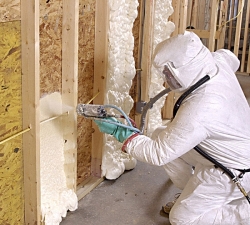
The use of liquid polystyrene foam as a heater differs in a mass of advantages, among which, first of all, its ability to fill the most insignificant cracks should be noted. In addition, the cost of this insulation is quite affordable compared to alternative options. We will talk about the features and scope of the use of liquid foam further.
Table of contents:
- Liquid foam: features and characteristics
- Liquid foam insulation - scope of use
- Advantages of wall insulation with liquid foam
- Warming of houses with liquid polystyrene - technology and properties
- Production technology for liquid foam
Liquid foam: features and characteristics
The production of polymer composition is based on the production of polymer composition. There are a large number of varieties of this material that distinguish:
- According to the intended purpose - a technical type of foam is more harmful to the environment, it contains toxic substances, polystyrene foam installed in residential premises has a different composition that is distinguished by absolute harmlessness and good degree of cleaning;
- According to manufacturing technology, materials are safer on the basis of already frozen foam, in the process of working with liquid foam there is a risk of distinguishing harmful substances, in the process of solving it.
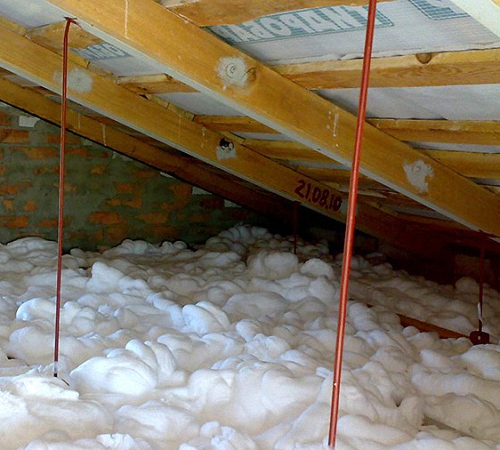
The most optimal option for liquid foam is made on the basis of carbamide-formaldehyde resins.
Each of the heater having a foamed purpose is formed by solidifying the material from which it is made. If the foam is applied directly to the surface, which must be insulated, then its adhesion with it increases several times than if the foam plate is installed on the very surface.
To prepare a liquid foam, you will need the presence of resin and hardener. A special machine is engaged in mixing and whipping all ingredients into a homogeneous foamy structure. Next, it is supplied with a pump and a hose directly for insulation.
There are special units that are engaged in this process. Although the option of making your own device is possible, which is responsible for the preparation of liquid foam. The price of purchased devices is quite high and reaches more than $ 3,000. For independent assembly of such a device, much less funds will be required.
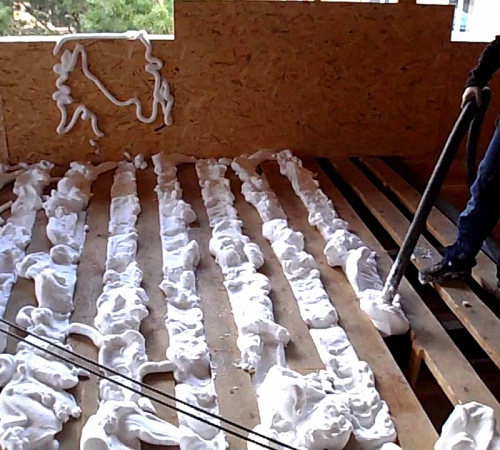
Purchased liquid foam is produced in the shape of a cylinder. After the foam enters the wall surface, it instantly hardens and becomes an excellent insulation.
Among the advantages of liquid foam should be highlighted:
1. An excellent level of adhesion with almost any materials.
2. Lack of need for the preparation of the surface before laying foam.
3. The formation of a seamless ideal seam that does not pass heat.
4. Great vapor permeability that allows you to preserve a healthy microclimate in the room.
5. It is used to warm surfaces of various composition: concrete, brick, wooden, etc.
6. Liquid foam is able to fill the entire space requiring insulation.
7. The absence or easy removal of surpluses and subtexts.
8. Environmental friendliness and harmlessness for human health is ensured if a qualitative type of foam is chosen.
9. Available cost, which is several times lower than alternative insulation in the form of mineral wool.
10. Good stability before mold, fungus and microorganisms.
11. The ability to function in a different temperature regime. Stability before temperature changes.
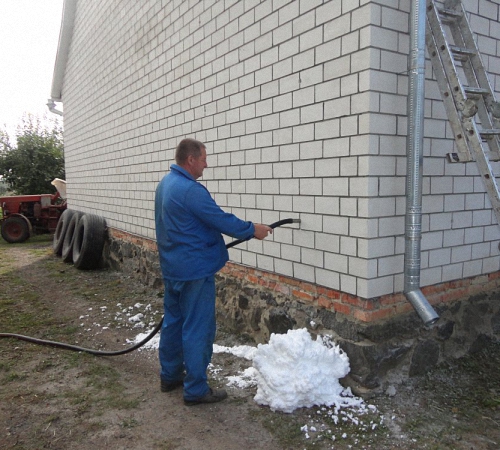
Despite this, liquid foam has certain disadvantages, namely:
- the possibility of a linear shrinkage that appears if the foam is filled without the required pressure;
- the presence of an unpleasant odor that disappears over time;
- the ability to absorb moisture, so the material should be protected from external influences on both sides;
- Due to the presence of formaldehyde, it is recommended for use as the outer layer of insulation or as an intermediate layer.
Liquid foam insulation - scope of use
Liquid foam has a limited use of indoors, but is still widespread in the process of insulation of horizontal planes, such as attic floors of the panel house. In addition, he copes with the insulation of the inter -star space and inclined areas.
Due to the presence of a liquid consistency, the foam perfectly insulates the space between the two sections of the walls, tightly adjacent to each other. It is used for insulation of formwork, false or floors made of wood.
Liquid foam can penetrate into the most remote sections of the walls. With its help, they are filled evenly and efficiently.
The use of liquid foam is associated with the insulation of containers. In addition, the unit with which insulation is carried out is also used for the manufacture of any kind of foam products, such as skirting boards, baguette, plates, embossed elements, etc.
Please note that all materials used in the process of manufacturing liquid foam should be carefully checked. Since there are many fraudsters or pseudo-factories that make fluids of foam at low cost. In this case, low -quality hardener is used, which is not only harmful, but also dangerous to human health.
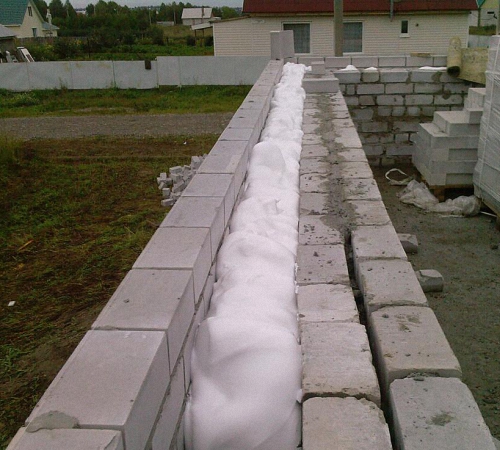
Liquid foam in cylinders is used as glue. In relation to the form and use, it has similar properties to mounting foam, although compared to it is characterized by higher thermal conductivity and vapor permeability.
It is suitable for fixing various kinds of insulation plates on the surface. To do this, you need to follow the instructions:
1. Make sure of the absence of defects on the surface. It should be even, without rusty spots, cracks and chips.
2. Clean the surface cleaning and improving.
3. In places where the glue is in contact with the stove, water should be applied, which will improve their adhesion.
4. The option of applying foam to the full surface is possible. If it is planned to save, then it is applied only in horizontal and diagonal directions.
5. As soon as the liquid foam is applied to the surface of the plate, it should be tightly pressed against the wall.
6. Further slabs are laid in the same way.
Consider that thermal insulation using foam, in the absence of a properly organized ventilation system, leads to the formation of condensate masses.
Application of liquid foam does not need a thorough preparation of the surface. This explains its wide popularity. When using a special installation that is engaged in the production of foam, only water and power supply are required for insulation. The application of foam is carried out using a hose, the size of which is limited to the distance from the unit producing the foam to the site of insulation.
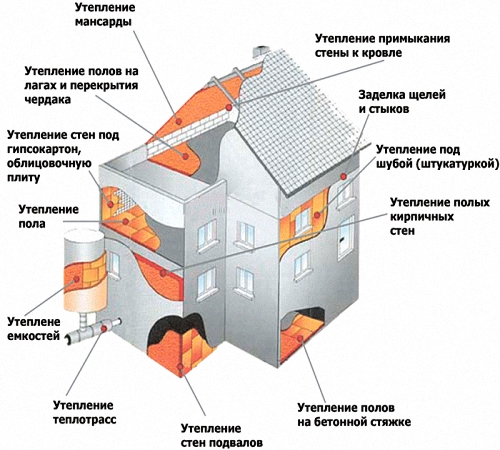
Liquid carbamide foam is used in such cases:
- internal work on gluing various kinds of structural elements, for thermal insulation of bathrooms, in order to ensure noise insulation;
- When conducting external purposes - facade insulation, waterproofing, installation of blocks made of concrete, etc.
The use of liquid foam is quite simple. Before applying it, the surface should be cleaned of dirt and dust, apply water to it to improve foam adhesion. It is better to carry out work at a temperature of about twenty degrees of heat. If the air temperature is lower, then the finished mixture is heated with warm water. If the weather is too hot, then the mixture is cooled in the same method.
Before using purchased liquid foam, you should first shake the balloon in which it is about 10-15 times. Thus, there will be a uniform distribution of material inside the cylinder.
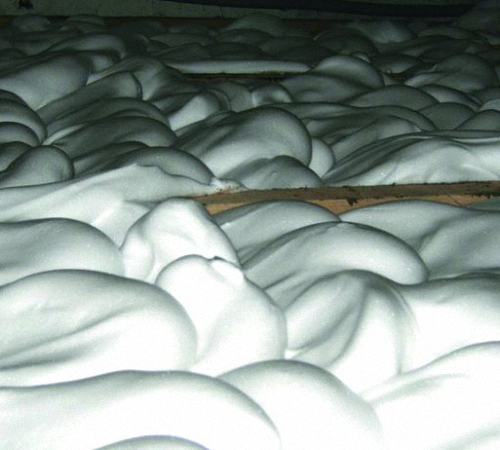
Advantages of wall insulation with liquid foam
If the polystyrene is made directly at the facility at which construction work is carried out, then its quality is much lower than that of the balloon liquid foam. The use of purchased foam, which is sold in a cylinder form, is distinguished by the following advantages:
- durability;
- environmental friendliness and harmlessness for health, provided that the foam is made of high -quality materials;
- fire safety and fire resistance;
- stability before biological effects;
- Resistance to insects and rodents.
Warming with liquid foam is characterized by an excellent ratio of the cost and quality of thermal insulation material. He is able to insulate both already erected walls and structures located at the construction stage. In addition, liquid foam is different:
- excellent thermal insulation characteristics;
- high techniques of use;
- the duration of operation is 45 years old;
- stability before high temperatures;
- affordable cost;
- fire safety;
- high density;
- good soundproofing characteristics.
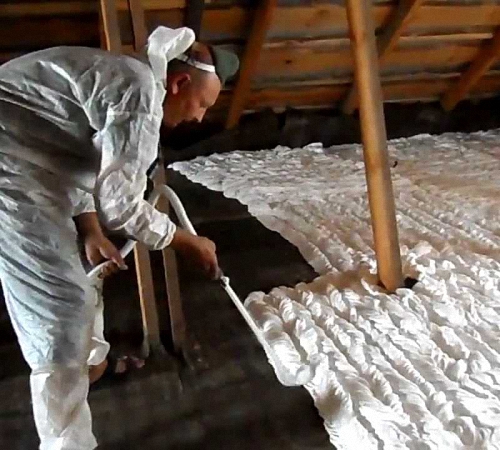
Warming of houses with liquid polystyrene - technology and properties
Filling with liquid polystyrene foam is carried out directly on the construction site, because the work on insulation is carried out quickly and easily. Penoizole is not inclined to increase, but is still distinguished by the presence of a small shrinkage to avoid the appearance of cracks that form as a result of shrinkage, the technology of filling with foamolisol should be clearly followed.
The material should be verified and high -quality. The minimum temperature for the work is six degrees. If the purchased type of foam is used, then you should first study the instructions for working with it.
Sometimes plate or tiny materials are used. Since the foam in a dry state is great for any surface. After pouring, a seamless layer is formed with excellent heat and sound insulation characteristics. This design practically does not pass moisture, despite the presence of small cracks in it.
The use of liquid foam is associated with insulation:
- external fences;
- insulation of walls of simple or combined composition;
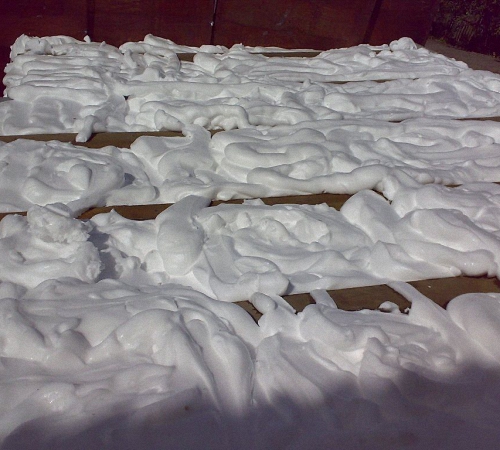
- thermal insulation design of brick consisting of three layers;
- filling the panels made of reinforced concrete;
- ensuring soundproofing and sound absorption;
- as a heater in layered panels;
- Inter -story insulation;
- insulation of roofs, attic, attic and balcony structures;
- insulation of garages, boxes, outbuildings, hangars, open -type sites, etc.;
- thermal insulation of the cottage, basements, vegetable stores;
- thermal insulation and sound insulation of wall panels, which are installed on a frame made of metal and wood;
- soil insulation.
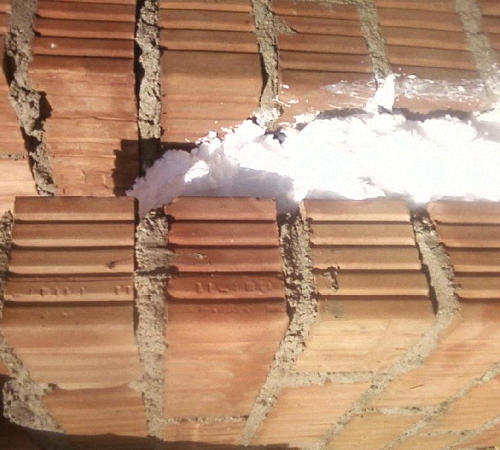
Production technology for liquid foam
To buy liquid foam, you should contact the manufacturers directly. They must be in advance in advance with all the documents necessary for work. In addition, you should worry about the availability of certificates confirming the quality of products.
The price is higher for purchased liquid foam, so the process of its independent manufacture is several times cheaper.
With the help of a correctly made liquid foam, you can do all the work efficiently, quickly and efficiently.
The procedure for manufacturing liquid foam includes mixing of water foam with carbamide resin and hardener. Next follows polymerization, that is, solidifying the finished substance.
After the drying is completed, the material takes the form of a foam usual for us. Foam is applied to the surface in the form of thick foam, which has a thick consistency. It insulates various kinds of building structures well. In order to fill all the air layers, it is necessary to provide a certain pressure under which the foam is supplied.
Further, the material freezes and begins to function as a heater. A house properly insulated with liquid foam, requires several times less heating costs than a building without insulation.
Work should start with a direct filling of the material to the surface. To get high -quality material, you should adhere to a certain technology for the installation of liquid foam.
To carry out thermal insulation in houses, with a total area of \u200b\u200b70 square meters, it will take about six hours of work. If you hire specialists who are warming with liquid foam, then the cost of work will be about $ 25 per square meter. Independent insulation will reduce expenses by two or even three times.
Warming with liquid foam involves pouring liquid foam into all empty sections of the walls. This procedure is carried out by pre -drilling the holes into which the hose is inserted. It is the pressure that provides a tight fit of the material to the wall, filling all cavities and the absence of cracks.
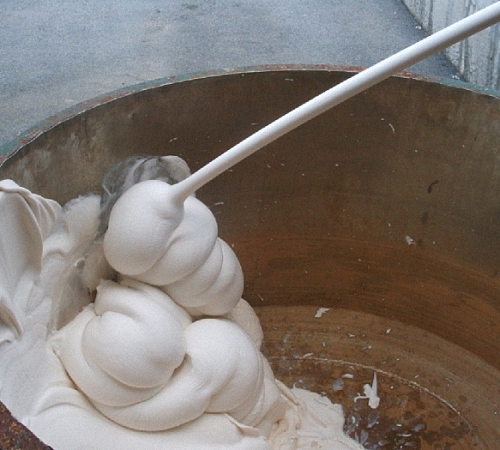
Subject to the correctness of the manufacture of liquid foam and its application, the use of this material as a heater allows you to get high -quality, inexpensive and effective insulation.
Liquid foam video:
